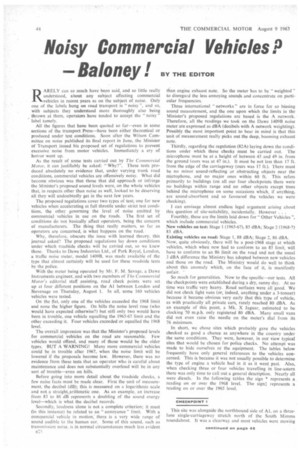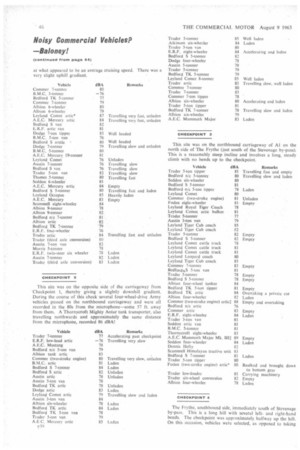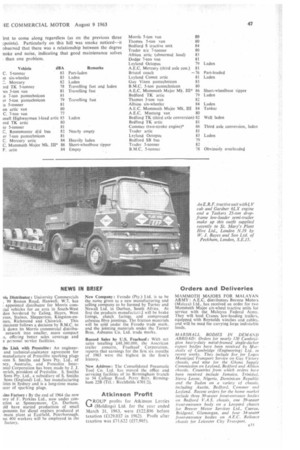Noisy Commercial Vehicles
Page 46

Page 48

Page 49

If you've noticed an error in this article please click here to report it so we can fix it.
-Baloney! BY THE EDITOR RARELY can so much have been said, and so little really understood, about any subject affecting commercial vehicles in recent years as on the subject of noise, Only one of the labels hung on road transport is "noisy ", and so, with subjects they understand more thoroughly also being thrown at them, operators have tended to accept the " noisy " label tamely.
All the figures that have been quoted so far—even in some sections of the transport Press—have been either theoretical or produced under test conditions. Soon after the Wilson Committee on noise published its final report in June, the Minister of Transport issued his proposed set of regulations to prevent excessive noise from motor vehicles. Immediately a cry of horror went up.
As the result of some tests carried out by The Commercial Motor, it can justifiably be asked: "Why?". These tests produced absolutely no evidence that, under varying trunk road conditions, commercial vehicles are offensively noisy. What did become obvious was that those that did approach or infringe the Minister's proposed sound levels were, on the whole vehicles that, in respects other than noise as well, looked to be deserving all they will undoubtedly get in the next few years.
The proposed regulations cover two types of test; one for new vehicles when accelerating at full throttle under strict test conditions. the other governing the level of noise emitted by commercial vehicles in use on the roads. The first set of conditions do not basically affect operators, being the concern of manufacturers. The thing that really matters, so far as operators are concerned, is what happens on the road.
Why, therefore, obscure the issue with learned theory, this journal asked? The proposed regulations lay down conditions under which roadside checks will be carried out, so we knew those. Thanks to Dawe Industries Ltd., of Park Royal, London, a traffic noise meter, model 1409B, was made available of the type that almost certainly will be used for these roadside tests by the police.
With the meter being operated by Mr. F. M. Savage, a Dawe Instruments engineer, and with two members of The Commercial Motor's editorial staff assisting, road check points were set up at four different positions on the Al between London and Stevenage on Thursday. August 1. In all, some 160 vehicles vehicles were tested.
Or' the flat, only one of the vehicles exceeded the 1968 limit and none the higher figure. On hills the noise level rose (who would have expected otherwise?) but still only two would have been in trouble, one vehicle equalling the 1965-67 limit and the other exceeding it. Four vehicles exceeded or equalled the 1968 level. .
The overall impression was that the Minister's proposed levels for commercial vehicles on the road are reasonable. Few vehicles would offend, and many of those would be the older types. BUT A WARNING! Many more commercial vehicles could be in trouble after 1967, when the noise limit wilt be lowered if the proposals become law. However, there was no evidence from these tests that an operator who is careful about maintenance and does not substantially overload will be in any sort of trouble—even on hilts.
Before going into more detail about the roadside checks, a few noise facts must be made clear. First the unit of measurement, the decibel (dB); this is measured on a logarithmic scale and not a straight,arithmetic one. As an example, an increase from 83 to 86 dli represents a doubting of the sound energy level—which is what the decibel records.
Secondly; loudness alone is not a complete criterion: it must (in this instance) be related to an " annoyance " limit. With a commercial vehicle in motion; there is a very wide range of sound audible to the human ear. Some of this sound. such as transmission noise, is in normal circumstances much less evident
than engine exhaust note. So the meter has to be " weighted " to disregard the less annoying sounds and concentrate on particular frequencies.
Three international " networks " are in force for so biasing sound measurement, and the one upon which the limits in the Minister's proposed regulations are based is the A network. Therefore, all the readings we took on the Dawe 1409B noise meter are expressed as dBA (decibels with A network weighting). Possibly the most important point to bear in mind is that this unit of measurement really picks out the deep, booming exhaust note.
Thirdly, regarding the regulation (82A) laying down the conditions under which these checks must be carried out. The microphone must be at a height of between 45 and 49 in. from the ground fours was at 47 in.). It must be not less than 17 ft, from the edge of the carriageway (ours was 17 ft.). There must be no minor sound-reflecting or obstructing objects near the microphone. and no major ones within 60 ft. This refers primarily to buildings (on all our four checkpoints there were no buildings within range and no other objects except trees behind the microphone on some occasions which, if anything, are sound-absorbent and so favoured the vehicles we were checking),
can envisage almost endless legal argument arising about this question of site-suitability, incidentally. However . .
Fourthly, these are the limits laid down for "Other Vehicles ", which include commercial vehicles.
New vehicles on test: Stage 1(1965-67), 85 dBA; Stage 2 (1968-?) 83 dBA.
Existing vehicles on road: Stage 1, 88 dBA; Stage 2, 86 dBA. Now, quite obviously, there will be a post-1968 stage at which vehicles, which when new had to conform to an 85 limit, will have to conform to an 86 limit on the road and not the usual 3 dBA difference the Ministry has adopted between new vehicles and those on the road. The Ministry would do well to think about this anomaly which, on the face of it, is manifestly unfair. • So much for generalities. Now to the specific—our tests. All the checkpoints were established during a dry, sunny day. At no time was traffic very heavy. Road surfaces were all good. We did not check light vans (or, indeed, anything under a 3-tonner) because it became obvious very early that this type of vehicle, as with practically all private cars, rarely reached 80 dBA. As an example of this point, a Mk. X Jaguar, estimated to be clocking 70 m.p.h. only registered 80 dBA. Many small vans did not even raise the needle on the meter's dial from its 76 minimum.
In short, we chose sites which probably gave the vehicles checked as good a chance as anywhere in the country under the same conditions. They were, however, in our view typical sites that would be chosen for police checks. No attempt was made to hide ourselves or the equipment. The tables below frequently have only general references to the vehicles concerned. This is because it was not usually possible to determine the type of engine a vehicle had in it as it went past. Also, when checking three or four vehicles travelling in line-astern there was only time to call out a general description. Nearly all were diesels. In the following tables the sign * represents a reading on or over the 1968 level. The sign: represents a reading on or over the 1965 level.
CHECKPOINT 1
This site was alongside the northbound side of Al, on a threelane single-carriageway stretch north of the South Mimms roundabout. It was a clearway and most vehicles were moving
at what appeared to be an average cruising speed. There was a very slight uphill gradient.
CHECKPOINT 2
This site was on the opposite side of the carriageway from *Checkpoint 1, thereby giving a slightly downhill gradient. During the course of this check several four-wheel-drive Army vehicles passed on the northbound carriageway and were all recorded in the 80s from the microphone—some 57 ft. away from them. A Thornycroft Mighty Antar tank transporter, also travelling northwards and approximately the same distance from the microphone, recorded 86 dBA!
CHECKPOINT 3
This site was on the northbound carriageway of Al on the north side of The Frythe (just south of the Stevenage by-pass). This is a reasonably steep incline and involves a long, steady climb with no bends up to the checkpoint.
CHECKPOINT 4
The Frythe, southbound side, immediately south of Stevenage by-pass. This is a long hill with several leftand right-hand bends. The checkpoint was approximately halfway up the hill. On this occasion, vehicles were selected, as opposed to taking
irst to come along regardless (as on the previous three zpoints). Particularly on this hill was smoke noticed—it observed that there was a relationship between the degree noke and noise, indicating that good maintenance solves than one problem.
































































































































